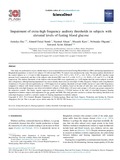| dc.contributor.author | Das, Anindya | |
| dc.contributor.author | Sumit, Ahmed Faisal | |
| dc.contributor.author | Ahsan, Nazmul | |
| dc.contributor.author | Kato, Masashi | |
| dc.contributor.author | Ohgami, Nobutaka | |
| dc.contributor.author | Akhand, Anwarul Azim | |
| dc.date.accessioned | 2022-03-03T07:03:00Z | |
| dc.date.available | 2022-03-03T07:03:00Z | |
| dc.date.copyright | 2018 | |
| dc.date.issued | 2018-03-13 | |
| dc.identifier.citation | Das, A., Sumit, A. F., Ahsan, N., Kato, M., Ohgami, N., & Akhand, A. A. (2018). Impairment of extra-high frequency auditory thresholds in subjects with elevated levels of fasting blood glucose. Journal of Otology, 13(1), 29-35. doi:10.1016/j.joto.2017.10.003 | en_US |
| dc.identifier.uri | http://hdl.handle.net/10361/16390 | |
| dc.description | This article was published in the Journal of Otology [Under a Creative Commons license ] and the definite version is available at : https://doi.org/10.1016/j.joto.2017.10.003 The Journal's website is at: https://www.sciencedirect.com/science/article/pii/S1672293017300946?via%3Dihub#! | en_US |
| dc.description.abstract | This study was performed to assess whether there is an association between elevated Fasting Blood Glucose (FBG) and hearing impairment in Bangladeshi population. A total of 142 subjects (72 with elevated FBG; 70 control) were included in the study. The mean auditory thresholds of the control subjects at 1, 4, 8 and 12 kHz frequencies were 6.35 ± 0.35, 10.07 ± 0.91, 27.57 ± 1.82, 51.28 ± 3.01 dB SPL (decibel sound pressure level), respectively and that of the subjects with elevated FBG were 8.33 ± 0.66, 14.37 ± 1.14, 38.96 ± 2.23, and 71.11 ± 2.96 dB, respectively. The auditory thresholds of the subjects with elevated FBG were significantly (p < 0.05) higher than the control subjects at all the above frequencies, although hearing impairment was most evidently observed at an extra-high (12 kHz) frequency. Subjects with a long duration of diabetes (>10 years) showed significantly (p < 0.05) higher level of auditory thresholds at 8 and 12 kHz, but not at 1 and 4 kHz frequencies, compared to subjects with shorter duration of diabetes (≤10 years). In addition, based on the data of odds ratio, more acute impairment of hearing at the extra-high frequency was observed in diabetic subjects of both older (>40 years) and younger (≤40 years) age groups compared to the respective controls. The binary logistic regression analysis showed a 5.79-fold increase in the odds of extra-high frequency hearing impairment in diabetic subjects after adjustment for age, gender and BMI. This study provides conclusive evidence that auditory threshold at an extra-high frequency could be a sensitive marker for hearing impairment in diabetic subjects. | en_US |
| dc.language.iso | en_US | en_US |
| dc.publisher | Science Direct | en_US |
| dc.relation.uri | https://www.sciencedirect.com/science/article/pii/S1672293017300946?via%3Dihub#! | |
| dc.subject | Fasting blood glucose | en_US |
| dc.subject | Hearing impairment | en_US |
| dc.subject | Auditory thresholds | en_US |
| dc.subject | Extra-high frequency | en_US |
| dc.title | Impairment of extra-high frequency auditory thresholds in subjects with elevated levels of fasting blood glucose | en_US |
| dc.type | Journal Article | en_US |
| dc.description.version | Published | |
| dc.contributor.department | Brac James P. Grant School of Public Health | |
| dc.identifier.doi | https://doi.org/10.1016/j.joto.2017.10.003 | |
| dc.relation.journal | The Journal of Otology | |

